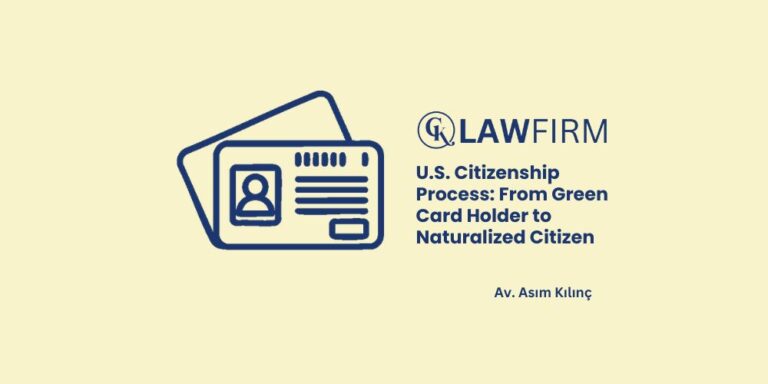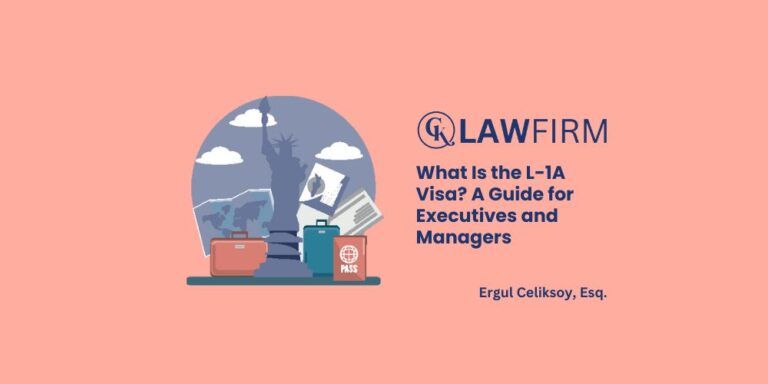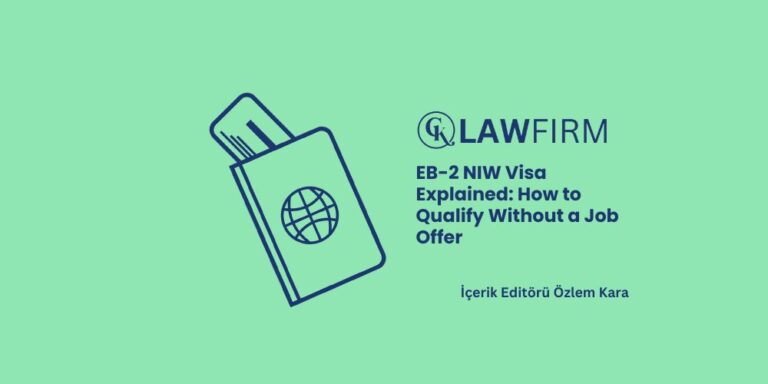Schedule an Appointment with Our Attorneys Now

Work Permit Leading to a Green Card | What is OPT?
Learn about Optional Practical Training (OPT), how to apply, eligibility, and its connection to Green Card application.
By Ergul Celiksoy, Immigration Attorney at CK Law Firm
Studying in the United States is an important step for many international students to achieve their career goals and access broader opportunities. Particularly, gaining practical experience in their field of study after completing their education in the U.S. is extremely valuable for those planning to live in the U.S. permanently. At this point, the OPT (Optional Practical Training) program serves as a bridge, offering students a significant opportunity to take a step towards obtaining a Green Card. In this article, I will provide detailed information on what OPT is, how to apply, its duration, STEM OPT extension, job change rules, and its relation to the Green Card process.
- What is OPT?
- Types of OPT
- Duration of the OPT Program
- Eligibility Requirements for OPT
- OPT Application Process
- STEM OPT Extension
- Rules for Changing Jobs on OPT
- OPT and H-1B Visa
- Green Card Application Process
- Connection Between OPT and Green Card
- What Happens When OPT Expires?
If you have any questions beyond those listed above, feel free to reach out to me via the comment section of this article, through LinkedIn messages, or directly via the website of CK Law Firm, where I am a co-founder.
What is OPT?
Optional Practical Training (OPT) is a work authorization program that allows international students studying in the U.S. on an F-1 visa to gain practical experience by working in a job related to their field of study, either before or after graduation. The OPT program supports students’ academic careers and helps them gain a competitive advantage in the U.S. job market.
The OPT program stands out as a strategic opportunity, especially for students aiming to stay longer in the U.S. and pave the way for applying for a Green Card.
Types of OPT
Optional Practical Training can be categorized into two main types, allowing students to obtain work authorization either before or after graduation:
- Pre-completion OPT: Students may request part-time work authorization (up to 20 hours per week) while continuing their studies. During school breaks, this can be extended to full-time. Pre-completion OPT is particularly beneficial for students looking to gain hands-on experience through summer internships or other temporary jobs related to their studies.
- Post-completion OPT: After completing their education, students can work full-time for one year in their field of study. This phase allows students to begin their professional careers and later apply for an H-1B visa and Green Card. Post-completion OPT serves as a critical starting point for a student’s career.
Duration of the OPT Program
The Optional Practical Training program is generally valid for 12 months after graduation. However, students in STEM (Science, Technology, Engineering, and Mathematics) fields can extend this period. STEM graduates may extend their OPT for an additional 24 months, bringing the total duration to 36 months.
Eligibility Requirements for OPT
To apply for OPT, students must meet certain eligibility criteria:
- F-1 Visa: Students applying for OPT must hold a valid F-1 student visa throughout their education in the U.S.
- Full-time Student Status: At the time of application, students must be enrolled as full-time students in their program of study.
- Related Field of Study: The job students work in under OPT must be directly related to their field of study. For instance, an engineering student must work in a related engineering job and cannot work in a job unrelated to their field of study.
- Form I-765: OPT applications are submitted by completing the Form I-765 provided by U.S. Citizenship and Immigration Services (USCIS).
OPT Application Process
Applying for OPT is a crucial step for students completing their education in the U.S. The process generally involves the following steps:
- Timing of Application: Students applying for post-completion OPT can start the process up to 90 days before their graduation date. The approval process, depending on the volume of applications, can take 3-5 months. Therefore, timely submission of applications is critical.
- USCIS Approval: Once the application is reviewed and approved by USCIS, the student will receive work authorization. It is important for students to ensure all documents are complete during this process.
- Employment Authorization Document (EAD): Once approved, students will receive an EAD card, which indicates their legal right to work under OPT.
- Job Search Process: Students must find a job related to their field of study during their OPT period. If a student is unable to secure a job, the unemployment period is limited to 90 days. If a student does not find a job within this time, their work authorization may be revoked.
STEM OPT Extension
Students graduating from STEM fields are eligible for an additional 24-month extension after their initial 12-month OPT period. This extension gives STEM graduates a total of 36 months to stay in the U.S. and prepare for applying for a Green Card.
To qualify for the STEM OPT extension, the student’s employer must be enrolled in the E-Verify system, a government program that verifies the employment eligibility of workers. The job must be related to the student’s field of study, and the employer must be registered in E-Verify.
Rules for Changing Jobs on OPT
Students working under OPT can switch to different jobs as long as they are in a field related to their studies. However, any job changes must be reported to USCIS. Students must not remain unemployed for more than a total of 90 days. When changing jobs, students should ensure that the position is still relevant to their field of study and meets the requirements of the OPT program.
OPT and H-1B Visa
OPT can be seen as a stepping stone towards obtaining an H-1B visa for students planning to work in the U.S. permanently. The H-1B visa is a work visa granted to foreign nationals in specialized occupations. If a student finds an employer during their OPT period who sponsors them for an H-1B visa, they can continue working in the U.S. and begin the Green Card application process.
Green Card Application Process
OPT is a critical step for students aiming to apply for a Green Card. If an employer sponsors an H-1B application and the student stays in the U.S. for a longer period, they can initiate the Green Card application process. Through employer sponsorship, a student can obtain permanent residency in the U.S.
Connection Between OPT and Green Card
OPT, particularly for students in STEM fields, plays a crucial role in the path towards obtaining a Green Card. With the STEM OPT extension, students can work in the U.S. for up to 36 months, increasing their chances of obtaining employer sponsorship for a Green Card. Students who gain work experience in the U.S. job market during OPT are more likely to secure an H-1B visa, paving the way for long-term residency.
What Happens When OPT Expires?
When OPT expires, students typically apply for an H-1B visa. The H-1B visa is sponsored by an employer and allows individuals to continue working in their specialized field. With the H-1B visa, individuals can apply for a Green Card and secure permanent residency. If an H-1B application is not submitted during the OPT period, and the student is not in a STEM field, they may risk losing their legal status in the U.S.
In conclusion, Optional Practical Training not only offers international students the opportunity to gain practical experience in their field of study but also serves as a crucial first step towards obtaining permanent residency in the U.S. For STEM graduates, the additional extension provides a significant advantage for those looking to apply for a Green Card.
Proper management of the OPT application process and collaboration with USCIS is essential. At CK Law Firm, we are here to support you at every stage, from OPT applications to the Green Card process. For more information and consultation services, feel free to reach out to us via cklawfirm.org, email us at info@cklawfirm.org, or contact us through LinkedIn.
Who is Attorney Ergül Çeliksoy?
Attorney Dr. Ergül Çeliksoy is a founding partner of CK Law Firm and also serves as an Assistant Professor of Law at the University of Nottingham. With extensive experience in U.S. immigration law, Dr. Çeliksoy completed a Master’s degree in international law and human rights law at the University of Nottingham in 2017, followed by a Ph.D. at the same university. His Ph.D., completed in 2022 at the University of Nottingham School of Law, marked a significant milestone in his academic career. Dr. Çeliksoy has published extensively in leading academic journals and is internationally recognized for his expertise in modern slavery, criminal justice, and criminal law. As a member of the California Bar, Dr. Çeliksoy offers exceptional service to his clients, particularly in U.S. immigration law cases. His expertise and experience in immigration law significantly contribute to CK Law Firm’s work in this area.
Dr. Çeliksoy provides comprehensive and strategic solutions to his clients in immigration law cases, helping secure their legal status in the U.S. His work on human rights and immigration processes, particularly in modern slavery and criminal law, effectively addresses the complex legal issues immigrants face. Dr. Çeliksoy reinforces CK Law Firm’s leadership in immigration law by offering reliable and effective legal consulting services to his clients, helping them build new lives in the United States.





